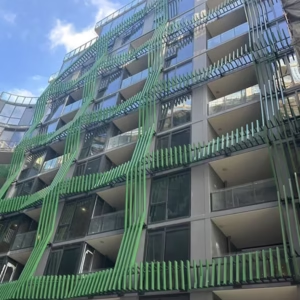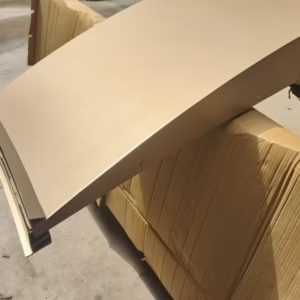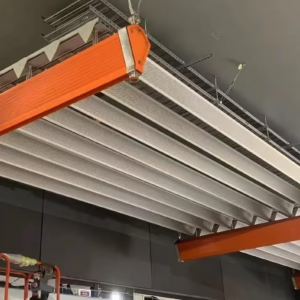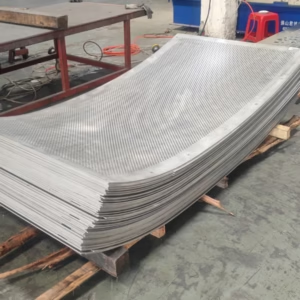Aluminum veneer, as a cost-effective metal decorative material, has become the mainstay of the curtain wall decoration industry. When shopping for aluminum veneer products, it is natural to need to understand how much the price of aluminum veneer is in the flat market. So, how is the price of aluminum veneer calculated? Although we can see some aluminum veneer price formulas on the Internet, for different aluminum veneer manufacturers, their offers still vary significantly. Specifically, quotes are given according to the project drawings and the actual situation of the site. After all, under different demand conditions, aluminum veneer prices are not the same.

Curtain Wall Aluminum Veneer Price Analysis
1. The Cost of Raw Materials
Aluminum Price Fluctuations on the Cost of
Aluminum ingot prices are influenced by the international market (such as the LME aluminum prices) and supply and demand. Price fluctuations are directly transmitted to the cost of aluminum veneer.
- Example: If the price of aluminum ingots rises by 1000 yuan per ton, the cost of aluminum veneer may increase by 5% to 8% (assuming that aluminum accounts for 60% of the cost).
Different Alloy Composition of the Price Difference
| Alloy Model | Feature | Price Difference (compared with 3003 alloy) |
|---|---|---|
| 3003 | Commonly used, general rust resistance | Benchmark price |
| 5052 | High strength, good corrosion resistance | +15% to 20% |
| 6061 | Good processability, high strength | +25% to 30% |
2. Processing
Influence of Surface Treatment on Price
| Processing Method | Process Characteristics | Cost Increase |
|---|---|---|
| Powder coating | Basic anti-corrosion, color optional | Base price |
| Fluorocarbon baking paint | Super weather-resistant, 20 years without fading color | +30% to 40% |
| Wood grain transfer | Imitation of wood grain effect, strong decorative | +25% to 35% |
| Anodizing | Metallic texture, wear-resistant | +50% to 60% |
Processing Precision and Complexity
- Bending times: Each additional complex bending increases the cost by 5% to 10%.
- Punching/engraving: For every 10% increase in hole density or engraving area, the cost rises by 8% to 12%.
- Shaped plate processing: Custom molds or laser cutting is required, the cost increases by 30%.

3. Specification and Thickness
Thickness and Price Relationship
| Thickness (mm) | Price Range ($/㎡) | Remarks |
|---|---|---|
| 1.5 | 180~260 | Commonly used for indoor or low-rise buildings |
| 2.0 | 240~320 | General-purpose, most cost-effective |
| 2.5 | 300~400 | High-rise or high wind pressure resistance requirement |
| 3.0 | 360~480 | Ultra-high-rise buildings or special needs |
Shaped Panel/Oversized Panel Additions
- Shaped panel: 15% to 40% markup according to processing difficulty.
- Oversized boards (e.g., more than 1.5m×4m): 20% to 35% price increase due to low material utilization.
4. Brand and Quality
Brand Premium
- Well-known brands: Prices are 10% to 30% higher than ordinary brands, but provide longer warranties (e.g., 10 to 15 years).
- Common brand: Lower price, but shorter warranty (usually 5 to 8 years).

Quality Standard Impact
| Type of Standard | Testing Requirements | Cost Increase |
|---|---|---|
| National standard | Basic performance testing | Benchmark price |
| European standard | Stricter corrosion resistance and wind pressure resistance test | +10% to 15% |
5. Other Factors

Transportation and Installation Costs
- Transportation cost: Calculated by distance, usually USD 0.8 to 1.2/㎡ per kilometer.
- Installation cost: Average market price $120 to 180/㎡, complex projects may exceed $200/㎡.
Market Supply and Demand
- Tight supply and demand period: Prices may go up by 10% to 15%.
- Loose supply and demand period: Price may go down by 5% to 8%.
Summary and Purchasing Suggestions
Core Price Drivers:
- Raw materials (40% to 50%)
- Processing technology (30% to 35%)
- Specifications and thickness (15% to 20%)
Procurement Recommendations:
- Define project requirements (thickness, surface treatment, wind pressure resistance level) to avoid over-design.
- Compare at least 3 suppliers and focus on total cost (material + processing + transportation + installation).
- Prioritize suppliers with certifications (e.g., ISO, European Standard) to reduce the risk of late maintenance.
Curtain Wall Aluminum Veneer Price FAQ Analysis
1. “Does the quotation of curtain wall aluminum veneer include transportation and installation cost?”
Answer:
The quotation range is different: In the actual procurement process, the quotation range given by different suppliers varies. Some manufacturers’ quotes include transportation costs and installation services, while some quotes are limited to material costs.
Specific project requirements: If the project has special requirements for transportation conditions (e.g., protective measures, transportation distance) and installation environment, additional costs are usually attached.
Suggestion: Before purchasing, you should confirm the composition of the offer with the supplier, make it clear whether the transportation and installation costs are included, and indicate the relevant terms in the contract to avoid disputes due to unclear costs at a later stage.

2. “How much will different processing techniques affect the price?”
Solution:
- Surface treatment method:
- Spraying: The process is simpler, the equipment investment is lower, and the cost is relatively low.
- Fluorocarbon baking paint: The cost will increase significantly due to higher process requirements and good weather resistance of the coating.
- Wood grain transfer printing: For the pursuit of decorative effect, the process requirements are higher, more labor-consuming, and the price is higher.
- Processing precision and complexity:
- Bending, punching, engraving, etc.: These processes, if the design is more complex, require high-precision equipment and longer processing hours, which directly leads to an increase in labor and equipment costs.
- Overall impact: The choice of each process will be different in product appearance and performance, and therefore will be directly reflected in the product offer. It is recommended to select the appropriate process according to the actual project requirements, while paying attention to the balance between cost and performance.




